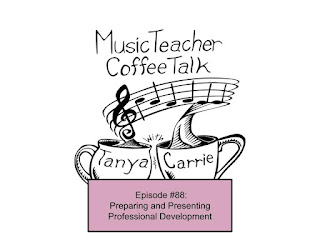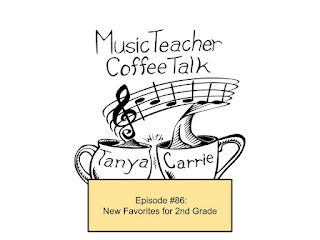Episode #88: Planning and Presenting Professional Devlopment
Choosing your topic:
Know your audience. Do research before your session to know what level and type of musical classes your participants teach and what their level of expertise and experience may be. Also, you could include poll at beginning of your PD to make quick adjustments as needed.
Know current trends and needs from the music ed community.
Know your venue, time frame, and session format
Online? In-person? What will your space be like?
How long is your session?
How in-depth can you go? Depends on time and audience.
Speak to your strengths and passions.
Organizing your session content:
Strive to incorporate active music making throughout the session and start your session with active music making to build community and get people engaged.
Add collaborative opportunities such as break-out rooms or small group activities.
Show videos of your students if you can.
Check your repertoire to make sure you are not including harmful pieces or activities that may promote cultural appropriation or insensitivity.
Include your sources as much as possible and give credit to whoever you have borrowed and adapted your ideas from.
Preparing for your session:
Create your outline, presentation slides, and session notes (handout).
Create thorough notes, including song notations and detailed game/activity directions.
Will you give your slideshow presentation? This is a personal preference.
Plan more than you know you’ll get to, but make a plan for what you won’t get to so that participants can access the things you don't go over in the session.
Consider a “freebie” offering such as a digital product you have created, a playlist, a unit or lesson plan, or a helpful templates.
Don’t rely on cloud-based resources. Be sure to have hard copies saved on your computer for recordings, slides, videos, etc.
Personal presenter preparation to set you up for success:
Practice your session with colleagues.
Sleep enough, eat enough, drink water, and know what you need and make it happen.
Make sure you request everything you need ahead of time. Remember to ask for tables, a microphone, water/lunch, instruments, and any other materials. Be sure a projector will be available and bring your own adapters (such as a Mac dongle) if needed.
Make clear to the participants if you allow pictures or audio/video recording during your session.
Read the room just like your classroom. If eyes are glazed, change gears!
Afterwards:
Thank the organization for having you.
Ask for feedback from participants and/or the hosting organization.
Make notes for yourself for if/when you repeat the session in the future.

%20(4).jpg)


Comments
Post a Comment